Market Analysis Report: Nike's Position and Strategies
VerifiedAdded on 2021/04/21
|11
|2919
|6425
Report
AI Summary
This report provides a thorough market analysis of Nike, a leading sports brand. It begins with an introduction to the company and its global operations, followed by an examination of its micro and macro environments using PESTLE analysis, covering political, economic, social, technological, environmental, and legal factors. A SWOT analysis highlights Nike's strengths, weaknesses, opportunities, and threats. The report then considers the implications of the SWOT and PESTLE analyses for Nike's strategic decision-making. It breaks down Nike's customer groups through demographic, geographic, and psychographic segmentation, along with profitability analysis. The report concludes with an assessment of Nike's current market position, its competitive advantages, and future growth strategies. The analysis emphasizes Nike's brand positioning, its appeal to consumers, and its strategies for maintaining a leading position in the sports industry. References are included to support the analysis.

Running Head: Undertake a Market Analysis
Undertake a Market Analysis
Nike Market Analysis
Undertake a Market Analysis
Nike Market Analysis
Paraphrase This Document
Need a fresh take? Get an instant paraphrase of this document with our AI Paraphraser
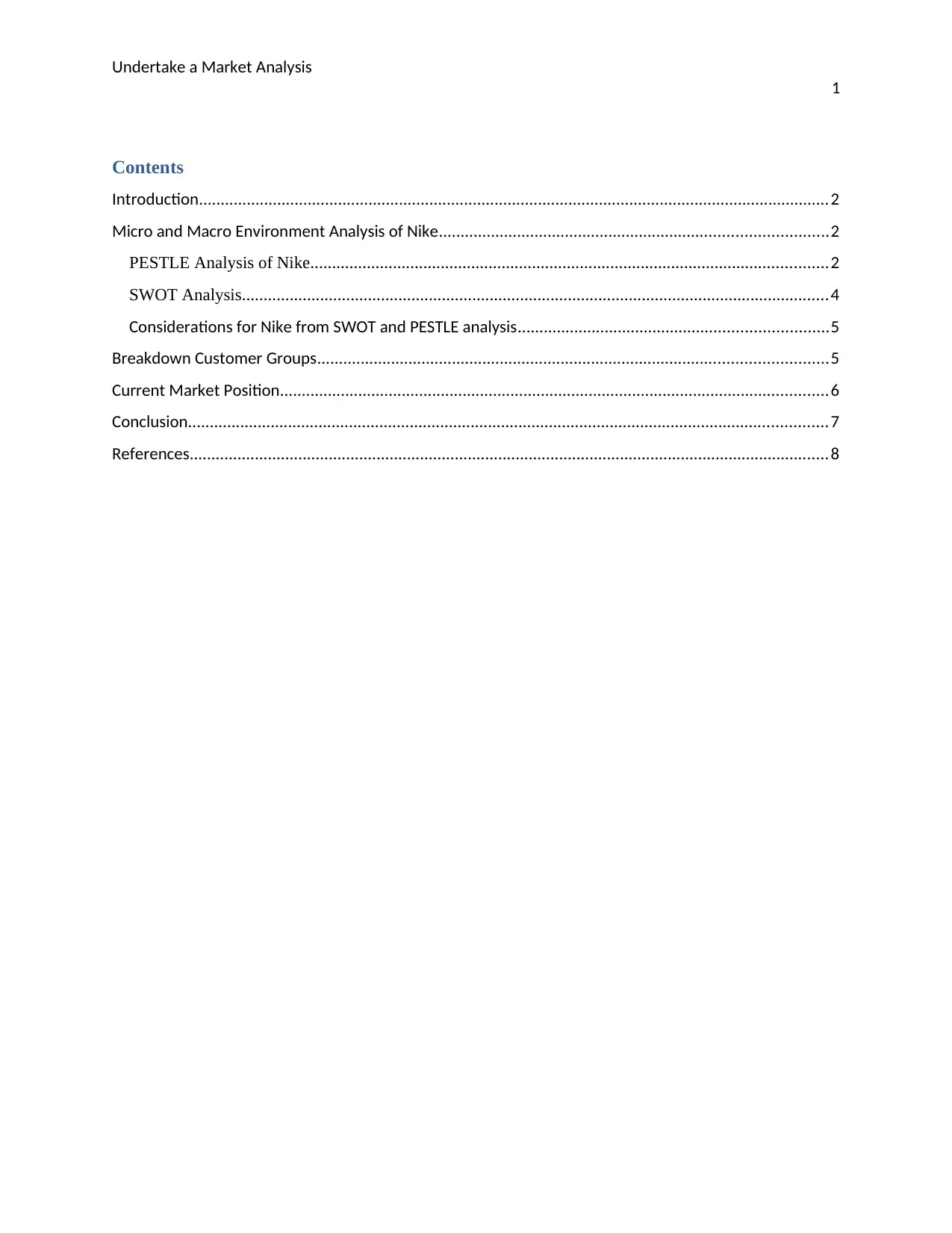
Undertake a Market Analysis
1
Contents
Introduction.................................................................................................................................................2
Micro and Macro Environment Analysis of Nike.........................................................................................2
PESTLE Analysis of Nike.......................................................................................................................2
SWOT Analysis.......................................................................................................................................4
Considerations for Nike from SWOT and PESTLE analysis.......................................................................5
Breakdown Customer Groups.....................................................................................................................5
Current Market Position..............................................................................................................................6
Conclusion...................................................................................................................................................7
References...................................................................................................................................................8
1
Contents
Introduction.................................................................................................................................................2
Micro and Macro Environment Analysis of Nike.........................................................................................2
PESTLE Analysis of Nike.......................................................................................................................2
SWOT Analysis.......................................................................................................................................4
Considerations for Nike from SWOT and PESTLE analysis.......................................................................5
Breakdown Customer Groups.....................................................................................................................5
Current Market Position..............................................................................................................................6
Conclusion...................................................................................................................................................7
References...................................................................................................................................................8
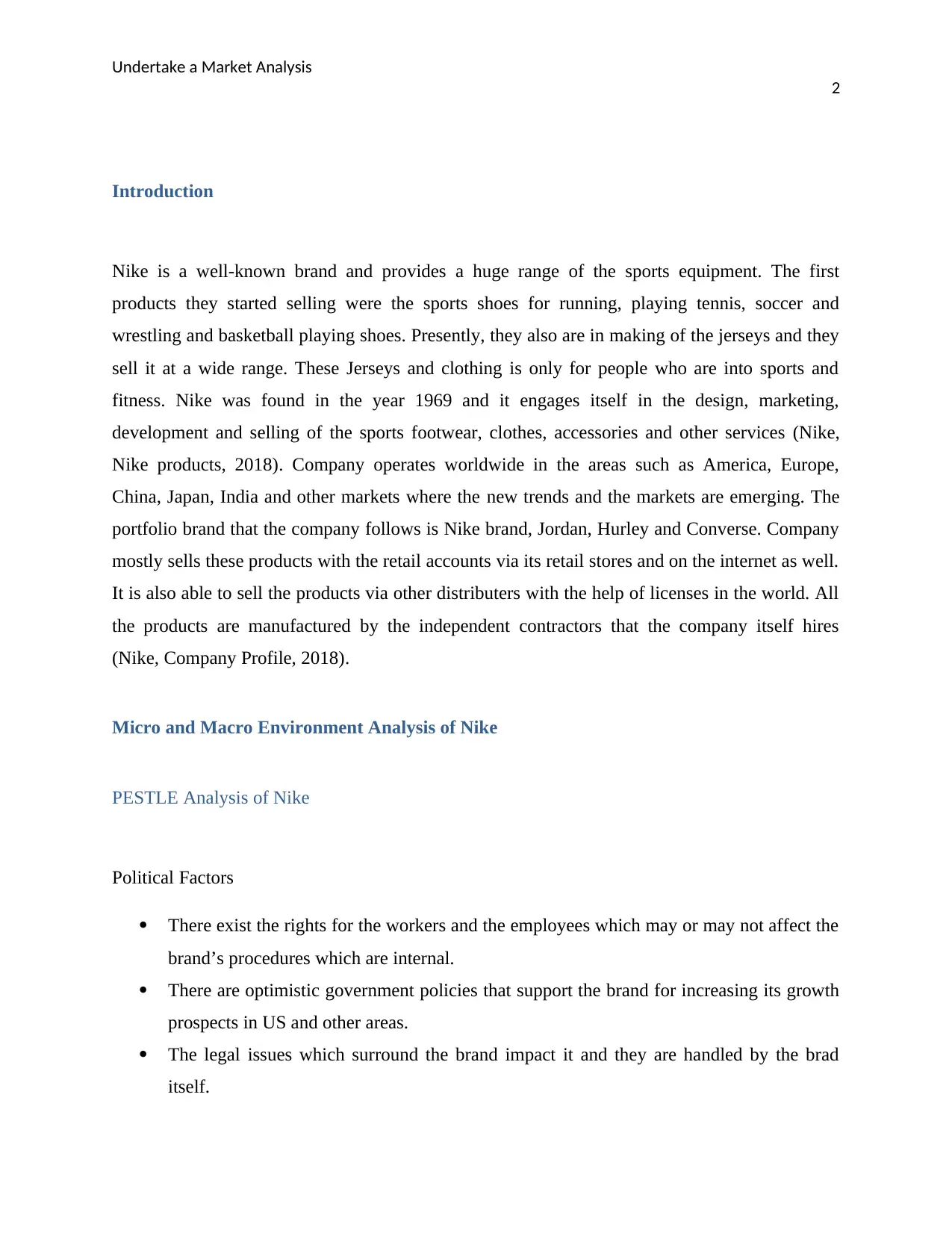
Undertake a Market Analysis
2
Introduction
Nike is a well-known brand and provides a huge range of the sports equipment. The first
products they started selling were the sports shoes for running, playing tennis, soccer and
wrestling and basketball playing shoes. Presently, they also are in making of the jerseys and they
sell it at a wide range. These Jerseys and clothing is only for people who are into sports and
fitness. Nike was found in the year 1969 and it engages itself in the design, marketing,
development and selling of the sports footwear, clothes, accessories and other services (Nike,
Nike products, 2018). Company operates worldwide in the areas such as America, Europe,
China, Japan, India and other markets where the new trends and the markets are emerging. The
portfolio brand that the company follows is Nike brand, Jordan, Hurley and Converse. Company
mostly sells these products with the retail accounts via its retail stores and on the internet as well.
It is also able to sell the products via other distributers with the help of licenses in the world. All
the products are manufactured by the independent contractors that the company itself hires
(Nike, Company Profile, 2018).
Micro and Macro Environment Analysis of Nike
PESTLE Analysis of Nike
Political Factors
There exist the rights for the workers and the employees which may or may not affect the
brand’s procedures which are internal.
There are optimistic government policies that support the brand for increasing its growth
prospects in US and other areas.
The legal issues which surround the brand impact it and they are handled by the brad
itself.
2
Introduction
Nike is a well-known brand and provides a huge range of the sports equipment. The first
products they started selling were the sports shoes for running, playing tennis, soccer and
wrestling and basketball playing shoes. Presently, they also are in making of the jerseys and they
sell it at a wide range. These Jerseys and clothing is only for people who are into sports and
fitness. Nike was found in the year 1969 and it engages itself in the design, marketing,
development and selling of the sports footwear, clothes, accessories and other services (Nike,
Nike products, 2018). Company operates worldwide in the areas such as America, Europe,
China, Japan, India and other markets where the new trends and the markets are emerging. The
portfolio brand that the company follows is Nike brand, Jordan, Hurley and Converse. Company
mostly sells these products with the retail accounts via its retail stores and on the internet as well.
It is also able to sell the products via other distributers with the help of licenses in the world. All
the products are manufactured by the independent contractors that the company itself hires
(Nike, Company Profile, 2018).
Micro and Macro Environment Analysis of Nike
PESTLE Analysis of Nike
Political Factors
There exist the rights for the workers and the employees which may or may not affect the
brand’s procedures which are internal.
There are optimistic government policies that support the brand for increasing its growth
prospects in US and other areas.
The legal issues which surround the brand impact it and they are handled by the brad
itself.
⊘ This is a preview!⊘
Do you want full access?
Subscribe today to unlock all pages.

Trusted by 1+ million students worldwide
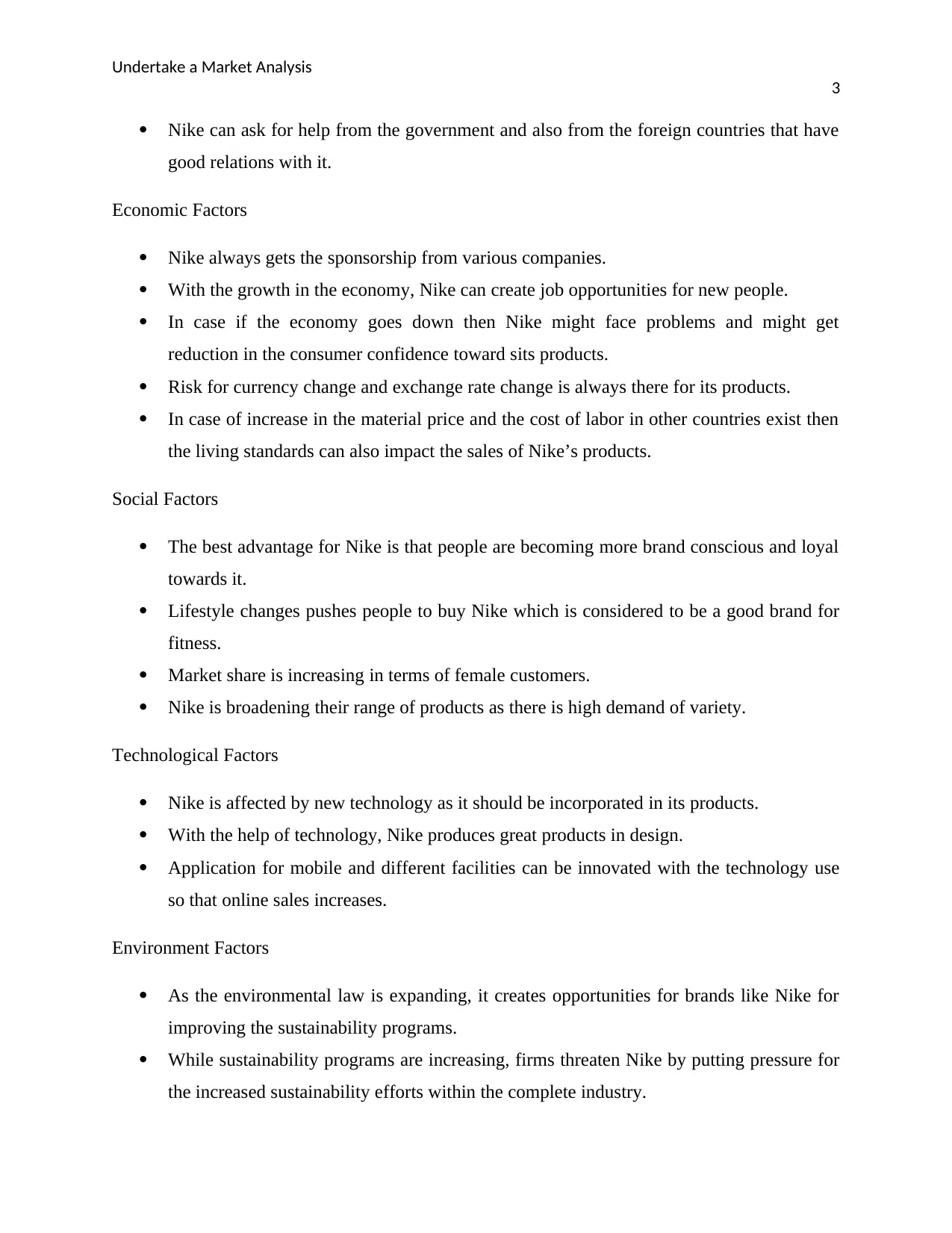
Undertake a Market Analysis
3
Nike can ask for help from the government and also from the foreign countries that have
good relations with it.
Economic Factors
Nike always gets the sponsorship from various companies.
With the growth in the economy, Nike can create job opportunities for new people.
In case if the economy goes down then Nike might face problems and might get
reduction in the consumer confidence toward sits products.
Risk for currency change and exchange rate change is always there for its products.
In case of increase in the material price and the cost of labor in other countries exist then
the living standards can also impact the sales of Nike’s products.
Social Factors
The best advantage for Nike is that people are becoming more brand conscious and loyal
towards it.
Lifestyle changes pushes people to buy Nike which is considered to be a good brand for
fitness.
Market share is increasing in terms of female customers.
Nike is broadening their range of products as there is high demand of variety.
Technological Factors
Nike is affected by new technology as it should be incorporated in its products.
With the help of technology, Nike produces great products in design.
Application for mobile and different facilities can be innovated with the technology use
so that online sales increases.
Environment Factors
As the environmental law is expanding, it creates opportunities for brands like Nike for
improving the sustainability programs.
While sustainability programs are increasing, firms threaten Nike by putting pressure for
the increased sustainability efforts within the complete industry.
3
Nike can ask for help from the government and also from the foreign countries that have
good relations with it.
Economic Factors
Nike always gets the sponsorship from various companies.
With the growth in the economy, Nike can create job opportunities for new people.
In case if the economy goes down then Nike might face problems and might get
reduction in the consumer confidence toward sits products.
Risk for currency change and exchange rate change is always there for its products.
In case of increase in the material price and the cost of labor in other countries exist then
the living standards can also impact the sales of Nike’s products.
Social Factors
The best advantage for Nike is that people are becoming more brand conscious and loyal
towards it.
Lifestyle changes pushes people to buy Nike which is considered to be a good brand for
fitness.
Market share is increasing in terms of female customers.
Nike is broadening their range of products as there is high demand of variety.
Technological Factors
Nike is affected by new technology as it should be incorporated in its products.
With the help of technology, Nike produces great products in design.
Application for mobile and different facilities can be innovated with the technology use
so that online sales increases.
Environment Factors
As the environmental law is expanding, it creates opportunities for brands like Nike for
improving the sustainability programs.
While sustainability programs are increasing, firms threaten Nike by putting pressure for
the increased sustainability efforts within the complete industry.
Paraphrase This Document
Need a fresh take? Get an instant paraphrase of this document with our AI Paraphraser
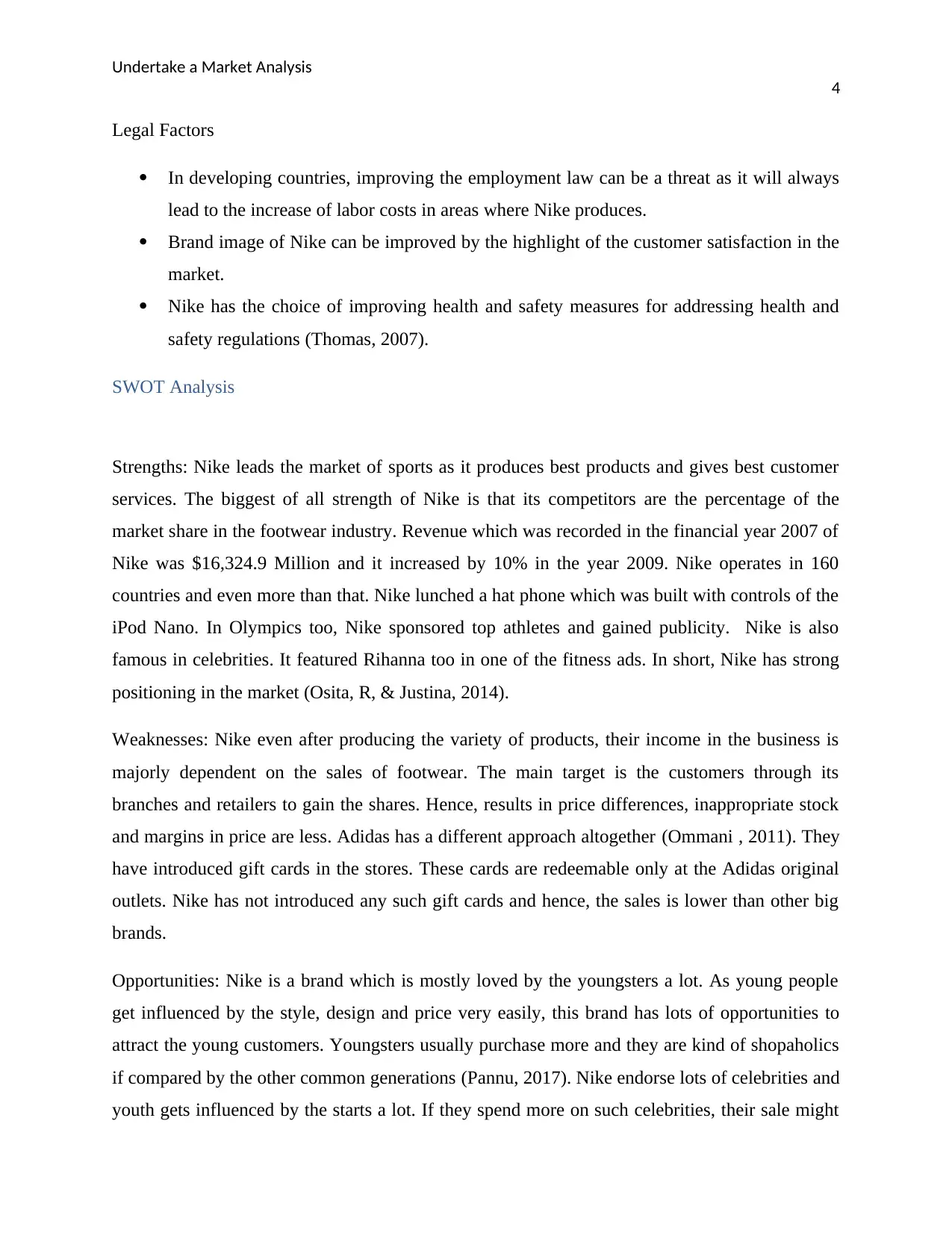
Undertake a Market Analysis
4
Legal Factors
In developing countries, improving the employment law can be a threat as it will always
lead to the increase of labor costs in areas where Nike produces.
Brand image of Nike can be improved by the highlight of the customer satisfaction in the
market.
Nike has the choice of improving health and safety measures for addressing health and
safety regulations (Thomas, 2007).
SWOT Analysis
Strengths: Nike leads the market of sports as it produces best products and gives best customer
services. The biggest of all strength of Nike is that its competitors are the percentage of the
market share in the footwear industry. Revenue which was recorded in the financial year 2007 of
Nike was $16,324.9 Million and it increased by 10% in the year 2009. Nike operates in 160
countries and even more than that. Nike lunched a hat phone which was built with controls of the
iPod Nano. In Olympics too, Nike sponsored top athletes and gained publicity. Nike is also
famous in celebrities. It featured Rihanna too in one of the fitness ads. In short, Nike has strong
positioning in the market (Osita, R, & Justina, 2014).
Weaknesses: Nike even after producing the variety of products, their income in the business is
majorly dependent on the sales of footwear. The main target is the customers through its
branches and retailers to gain the shares. Hence, results in price differences, inappropriate stock
and margins in price are less. Adidas has a different approach altogether (Ommani , 2011). They
have introduced gift cards in the stores. These cards are redeemable only at the Adidas original
outlets. Nike has not introduced any such gift cards and hence, the sales is lower than other big
brands.
Opportunities: Nike is a brand which is mostly loved by the youngsters a lot. As young people
get influenced by the style, design and price very easily, this brand has lots of opportunities to
attract the young customers. Youngsters usually purchase more and they are kind of shopaholics
if compared by the other common generations (Pannu, 2017). Nike endorse lots of celebrities and
youth gets influenced by the starts a lot. If they spend more on such celebrities, their sale might
4
Legal Factors
In developing countries, improving the employment law can be a threat as it will always
lead to the increase of labor costs in areas where Nike produces.
Brand image of Nike can be improved by the highlight of the customer satisfaction in the
market.
Nike has the choice of improving health and safety measures for addressing health and
safety regulations (Thomas, 2007).
SWOT Analysis
Strengths: Nike leads the market of sports as it produces best products and gives best customer
services. The biggest of all strength of Nike is that its competitors are the percentage of the
market share in the footwear industry. Revenue which was recorded in the financial year 2007 of
Nike was $16,324.9 Million and it increased by 10% in the year 2009. Nike operates in 160
countries and even more than that. Nike lunched a hat phone which was built with controls of the
iPod Nano. In Olympics too, Nike sponsored top athletes and gained publicity. Nike is also
famous in celebrities. It featured Rihanna too in one of the fitness ads. In short, Nike has strong
positioning in the market (Osita, R, & Justina, 2014).
Weaknesses: Nike even after producing the variety of products, their income in the business is
majorly dependent on the sales of footwear. The main target is the customers through its
branches and retailers to gain the shares. Hence, results in price differences, inappropriate stock
and margins in price are less. Adidas has a different approach altogether (Ommani , 2011). They
have introduced gift cards in the stores. These cards are redeemable only at the Adidas original
outlets. Nike has not introduced any such gift cards and hence, the sales is lower than other big
brands.
Opportunities: Nike is a brand which is mostly loved by the youngsters a lot. As young people
get influenced by the style, design and price very easily, this brand has lots of opportunities to
attract the young customers. Youngsters usually purchase more and they are kind of shopaholics
if compared by the other common generations (Pannu, 2017). Nike endorse lots of celebrities and
youth gets influenced by the starts a lot. If they spend more on such celebrities, their sale might
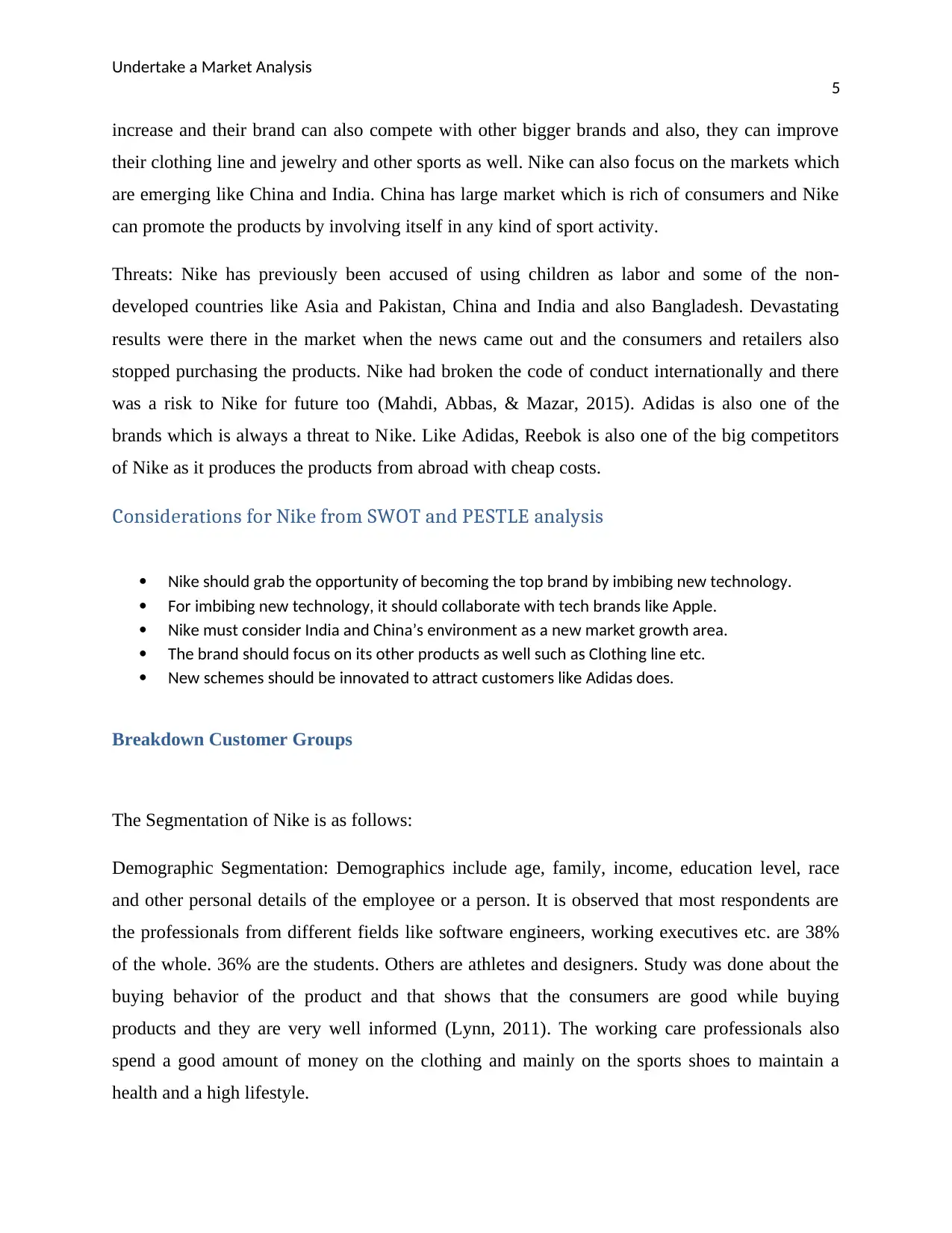
Undertake a Market Analysis
5
increase and their brand can also compete with other bigger brands and also, they can improve
their clothing line and jewelry and other sports as well. Nike can also focus on the markets which
are emerging like China and India. China has large market which is rich of consumers and Nike
can promote the products by involving itself in any kind of sport activity.
Threats: Nike has previously been accused of using children as labor and some of the non-
developed countries like Asia and Pakistan, China and India and also Bangladesh. Devastating
results were there in the market when the news came out and the consumers and retailers also
stopped purchasing the products. Nike had broken the code of conduct internationally and there
was a risk to Nike for future too (Mahdi, Abbas, & Mazar, 2015). Adidas is also one of the
brands which is always a threat to Nike. Like Adidas, Reebok is also one of the big competitors
of Nike as it produces the products from abroad with cheap costs.
Considerations for Nike from SWOT and PESTLE analysis
Nike should grab the opportunity of becoming the top brand by imbibing new technology.
For imbibing new technology, it should collaborate with tech brands like Apple.
Nike must consider India and China’s environment as a new market growth area.
The brand should focus on its other products as well such as Clothing line etc.
New schemes should be innovated to attract customers like Adidas does.
Breakdown Customer Groups
The Segmentation of Nike is as follows:
Demographic Segmentation: Demographics include age, family, income, education level, race
and other personal details of the employee or a person. It is observed that most respondents are
the professionals from different fields like software engineers, working executives etc. are 38%
of the whole. 36% are the students. Others are athletes and designers. Study was done about the
buying behavior of the product and that shows that the consumers are good while buying
products and they are very well informed (Lynn, 2011). The working care professionals also
spend a good amount of money on the clothing and mainly on the sports shoes to maintain a
health and a high lifestyle.
5
increase and their brand can also compete with other bigger brands and also, they can improve
their clothing line and jewelry and other sports as well. Nike can also focus on the markets which
are emerging like China and India. China has large market which is rich of consumers and Nike
can promote the products by involving itself in any kind of sport activity.
Threats: Nike has previously been accused of using children as labor and some of the non-
developed countries like Asia and Pakistan, China and India and also Bangladesh. Devastating
results were there in the market when the news came out and the consumers and retailers also
stopped purchasing the products. Nike had broken the code of conduct internationally and there
was a risk to Nike for future too (Mahdi, Abbas, & Mazar, 2015). Adidas is also one of the
brands which is always a threat to Nike. Like Adidas, Reebok is also one of the big competitors
of Nike as it produces the products from abroad with cheap costs.
Considerations for Nike from SWOT and PESTLE analysis
Nike should grab the opportunity of becoming the top brand by imbibing new technology.
For imbibing new technology, it should collaborate with tech brands like Apple.
Nike must consider India and China’s environment as a new market growth area.
The brand should focus on its other products as well such as Clothing line etc.
New schemes should be innovated to attract customers like Adidas does.
Breakdown Customer Groups
The Segmentation of Nike is as follows:
Demographic Segmentation: Demographics include age, family, income, education level, race
and other personal details of the employee or a person. It is observed that most respondents are
the professionals from different fields like software engineers, working executives etc. are 38%
of the whole. 36% are the students. Others are athletes and designers. Study was done about the
buying behavior of the product and that shows that the consumers are good while buying
products and they are very well informed (Lynn, 2011). The working care professionals also
spend a good amount of money on the clothing and mainly on the sports shoes to maintain a
health and a high lifestyle.
⊘ This is a preview!⊘
Do you want full access?
Subscribe today to unlock all pages.

Trusted by 1+ million students worldwide
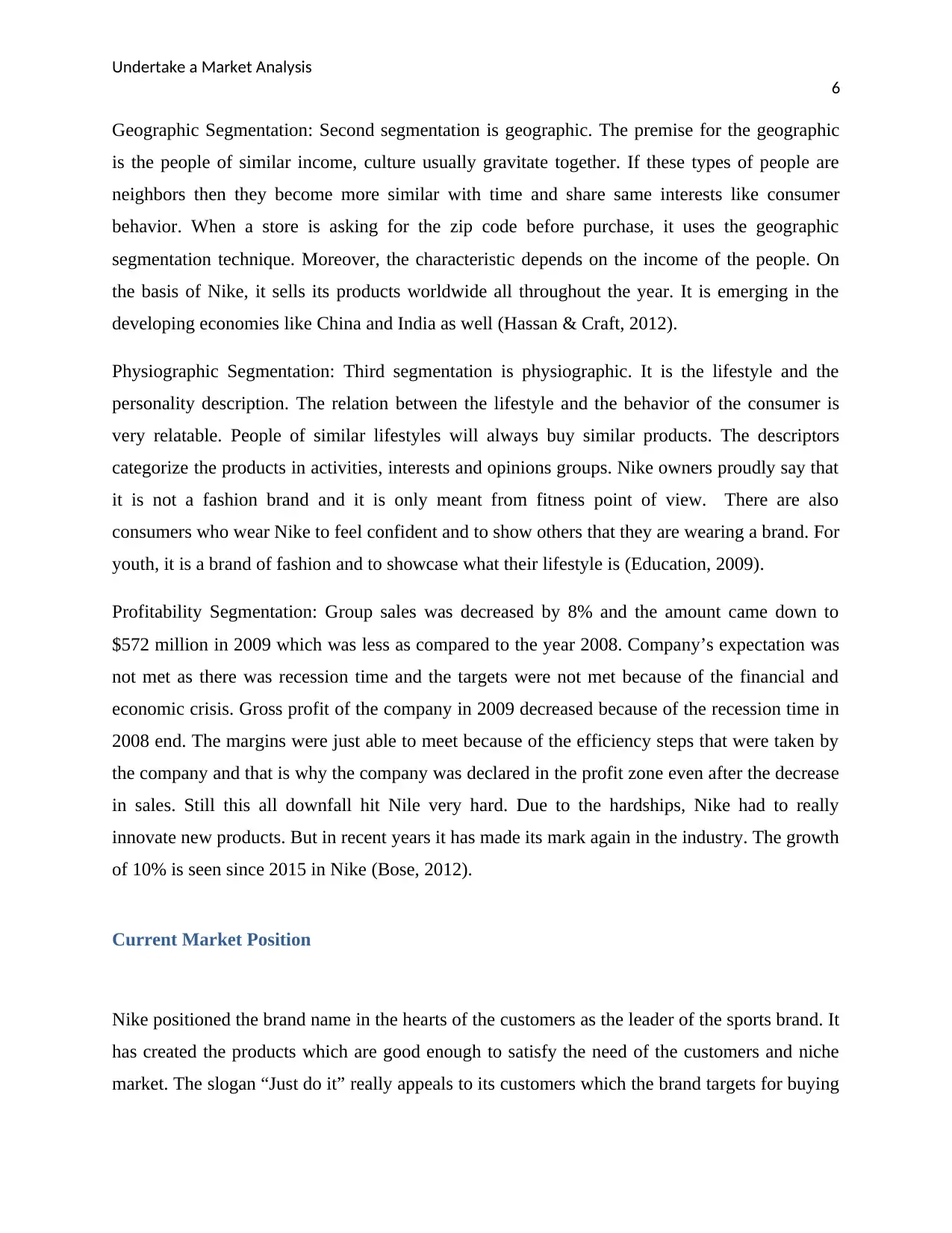
Undertake a Market Analysis
6
Geographic Segmentation: Second segmentation is geographic. The premise for the geographic
is the people of similar income, culture usually gravitate together. If these types of people are
neighbors then they become more similar with time and share same interests like consumer
behavior. When a store is asking for the zip code before purchase, it uses the geographic
segmentation technique. Moreover, the characteristic depends on the income of the people. On
the basis of Nike, it sells its products worldwide all throughout the year. It is emerging in the
developing economies like China and India as well (Hassan & Craft, 2012).
Physiographic Segmentation: Third segmentation is physiographic. It is the lifestyle and the
personality description. The relation between the lifestyle and the behavior of the consumer is
very relatable. People of similar lifestyles will always buy similar products. The descriptors
categorize the products in activities, interests and opinions groups. Nike owners proudly say that
it is not a fashion brand and it is only meant from fitness point of view. There are also
consumers who wear Nike to feel confident and to show others that they are wearing a brand. For
youth, it is a brand of fashion and to showcase what their lifestyle is (Education, 2009).
Profitability Segmentation: Group sales was decreased by 8% and the amount came down to
$572 million in 2009 which was less as compared to the year 2008. Company’s expectation was
not met as there was recession time and the targets were not met because of the financial and
economic crisis. Gross profit of the company in 2009 decreased because of the recession time in
2008 end. The margins were just able to meet because of the efficiency steps that were taken by
the company and that is why the company was declared in the profit zone even after the decrease
in sales. Still this all downfall hit Nile very hard. Due to the hardships, Nike had to really
innovate new products. But in recent years it has made its mark again in the industry. The growth
of 10% is seen since 2015 in Nike (Bose, 2012).
Current Market Position
Nike positioned the brand name in the hearts of the customers as the leader of the sports brand. It
has created the products which are good enough to satisfy the need of the customers and niche
market. The slogan “Just do it” really appeals to its customers which the brand targets for buying
6
Geographic Segmentation: Second segmentation is geographic. The premise for the geographic
is the people of similar income, culture usually gravitate together. If these types of people are
neighbors then they become more similar with time and share same interests like consumer
behavior. When a store is asking for the zip code before purchase, it uses the geographic
segmentation technique. Moreover, the characteristic depends on the income of the people. On
the basis of Nike, it sells its products worldwide all throughout the year. It is emerging in the
developing economies like China and India as well (Hassan & Craft, 2012).
Physiographic Segmentation: Third segmentation is physiographic. It is the lifestyle and the
personality description. The relation between the lifestyle and the behavior of the consumer is
very relatable. People of similar lifestyles will always buy similar products. The descriptors
categorize the products in activities, interests and opinions groups. Nike owners proudly say that
it is not a fashion brand and it is only meant from fitness point of view. There are also
consumers who wear Nike to feel confident and to show others that they are wearing a brand. For
youth, it is a brand of fashion and to showcase what their lifestyle is (Education, 2009).
Profitability Segmentation: Group sales was decreased by 8% and the amount came down to
$572 million in 2009 which was less as compared to the year 2008. Company’s expectation was
not met as there was recession time and the targets were not met because of the financial and
economic crisis. Gross profit of the company in 2009 decreased because of the recession time in
2008 end. The margins were just able to meet because of the efficiency steps that were taken by
the company and that is why the company was declared in the profit zone even after the decrease
in sales. Still this all downfall hit Nile very hard. Due to the hardships, Nike had to really
innovate new products. But in recent years it has made its mark again in the industry. The growth
of 10% is seen since 2015 in Nike (Bose, 2012).
Current Market Position
Nike positioned the brand name in the hearts of the customers as the leader of the sports brand. It
has created the products which are good enough to satisfy the need of the customers and niche
market. The slogan “Just do it” really appeals to its customers which the brand targets for buying
Paraphrase This Document
Need a fresh take? Get an instant paraphrase of this document with our AI Paraphraser
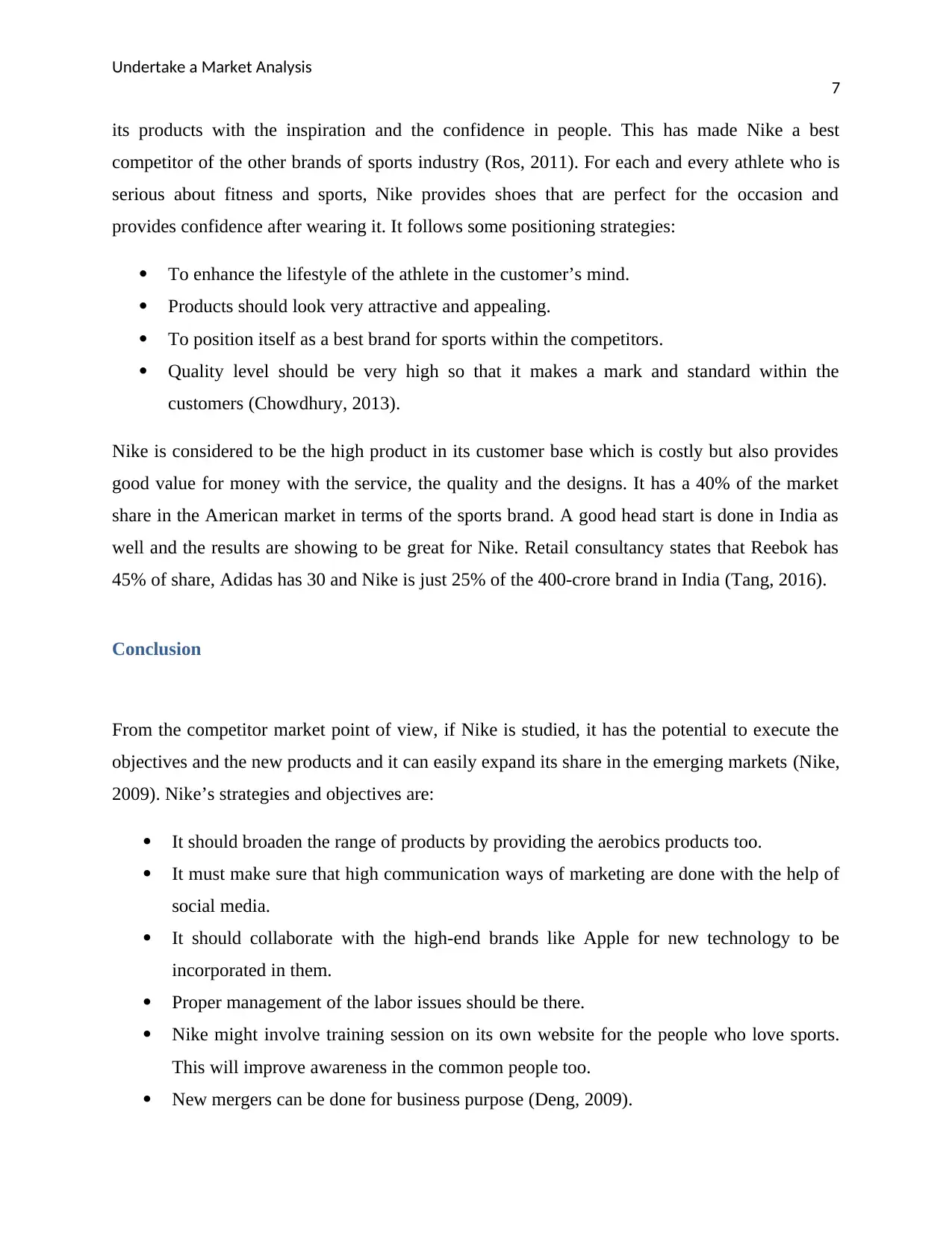
Undertake a Market Analysis
7
its products with the inspiration and the confidence in people. This has made Nike a best
competitor of the other brands of sports industry (Ros, 2011). For each and every athlete who is
serious about fitness and sports, Nike provides shoes that are perfect for the occasion and
provides confidence after wearing it. It follows some positioning strategies:
To enhance the lifestyle of the athlete in the customer’s mind.
Products should look very attractive and appealing.
To position itself as a best brand for sports within the competitors.
Quality level should be very high so that it makes a mark and standard within the
customers (Chowdhury, 2013).
Nike is considered to be the high product in its customer base which is costly but also provides
good value for money with the service, the quality and the designs. It has a 40% of the market
share in the American market in terms of the sports brand. A good head start is done in India as
well and the results are showing to be great for Nike. Retail consultancy states that Reebok has
45% of share, Adidas has 30 and Nike is just 25% of the 400-crore brand in India (Tang, 2016).
Conclusion
From the competitor market point of view, if Nike is studied, it has the potential to execute the
objectives and the new products and it can easily expand its share in the emerging markets (Nike,
2009). Nike’s strategies and objectives are:
It should broaden the range of products by providing the aerobics products too.
It must make sure that high communication ways of marketing are done with the help of
social media.
It should collaborate with the high-end brands like Apple for new technology to be
incorporated in them.
Proper management of the labor issues should be there.
Nike might involve training session on its own website for the people who love sports.
This will improve awareness in the common people too.
New mergers can be done for business purpose (Deng, 2009).
7
its products with the inspiration and the confidence in people. This has made Nike a best
competitor of the other brands of sports industry (Ros, 2011). For each and every athlete who is
serious about fitness and sports, Nike provides shoes that are perfect for the occasion and
provides confidence after wearing it. It follows some positioning strategies:
To enhance the lifestyle of the athlete in the customer’s mind.
Products should look very attractive and appealing.
To position itself as a best brand for sports within the competitors.
Quality level should be very high so that it makes a mark and standard within the
customers (Chowdhury, 2013).
Nike is considered to be the high product in its customer base which is costly but also provides
good value for money with the service, the quality and the designs. It has a 40% of the market
share in the American market in terms of the sports brand. A good head start is done in India as
well and the results are showing to be great for Nike. Retail consultancy states that Reebok has
45% of share, Adidas has 30 and Nike is just 25% of the 400-crore brand in India (Tang, 2016).
Conclusion
From the competitor market point of view, if Nike is studied, it has the potential to execute the
objectives and the new products and it can easily expand its share in the emerging markets (Nike,
2009). Nike’s strategies and objectives are:
It should broaden the range of products by providing the aerobics products too.
It must make sure that high communication ways of marketing are done with the help of
social media.
It should collaborate with the high-end brands like Apple for new technology to be
incorporated in them.
Proper management of the labor issues should be there.
Nike might involve training session on its own website for the people who love sports.
This will improve awareness in the common people too.
New mergers can be done for business purpose (Deng, 2009).
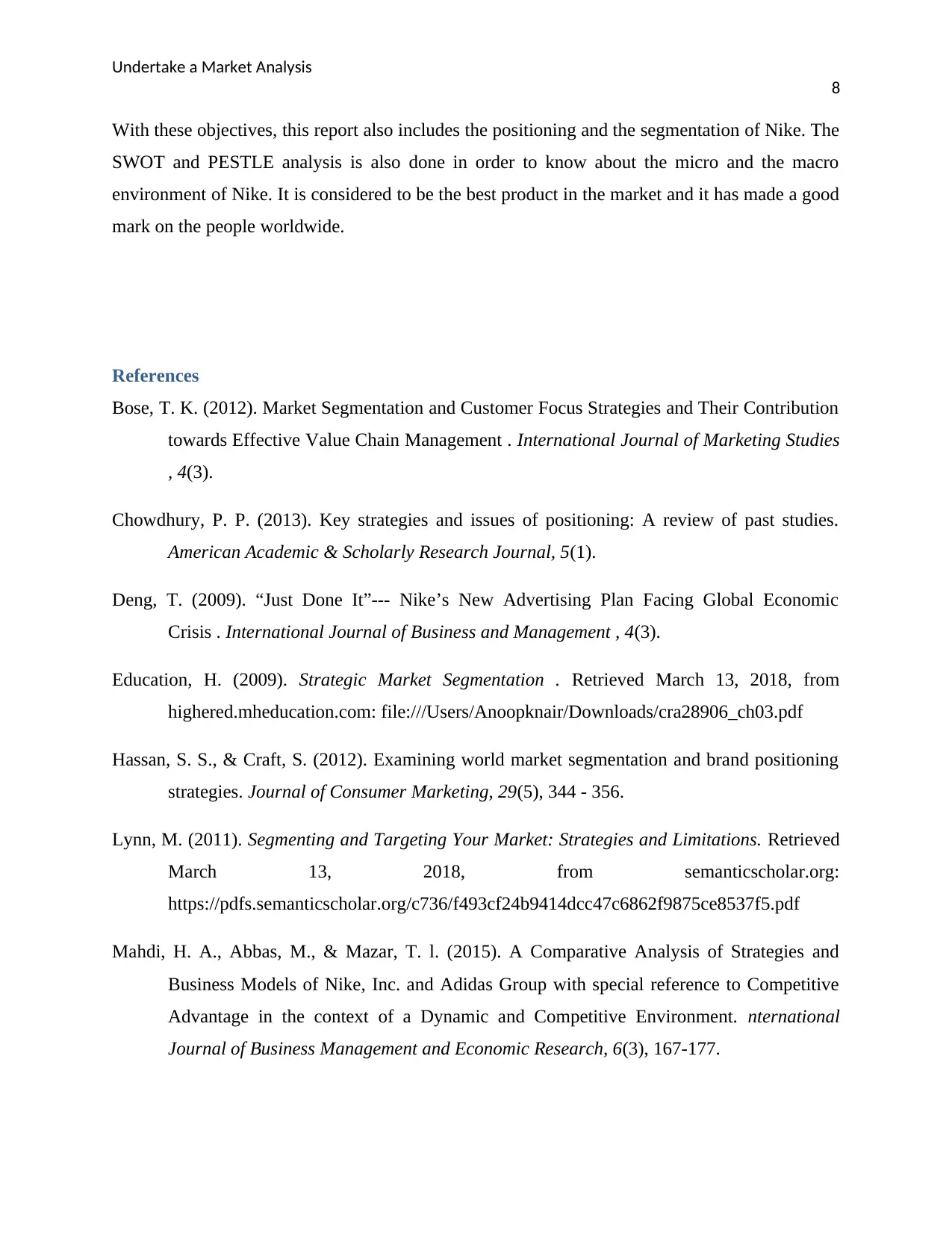
Undertake a Market Analysis
8
With these objectives, this report also includes the positioning and the segmentation of Nike. The
SWOT and PESTLE analysis is also done in order to know about the micro and the macro
environment of Nike. It is considered to be the best product in the market and it has made a good
mark on the people worldwide.
References
Bose, T. K. (2012). Market Segmentation and Customer Focus Strategies and Their Contribution
towards Effective Value Chain Management . International Journal of Marketing Studies
, 4(3).
Chowdhury, P. P. (2013). Key strategies and issues of positioning: A review of past studies.
American Academic & Scholarly Research Journal, 5(1).
Deng, T. (2009). “Just Done It”--- Nike’s New Advertising Plan Facing Global Economic
Crisis . International Journal of Business and Management , 4(3).
Education, H. (2009). Strategic Market Segmentation . Retrieved March 13, 2018, from
highered.mheducation.com: file:///Users/Anoopknair/Downloads/cra28906_ch03.pdf
Hassan, S. S., & Craft, S. (2012). Examining world market segmentation and brand positioning
strategies. Journal of Consumer Marketing, 29(5), 344 - 356.
Lynn, M. (2011). Segmenting and Targeting Your Market: Strategies and Limitations. Retrieved
March 13, 2018, from semanticscholar.org:
https://pdfs.semanticscholar.org/c736/f493cf24b9414dcc47c6862f9875ce8537f5.pdf
Mahdi, H. A., Abbas, M., & Mazar, T. l. (2015). A Comparative Analysis of Strategies and
Business Models of Nike, Inc. and Adidas Group with special reference to Competitive
Advantage in the context of a Dynamic and Competitive Environment. nternational
Journal of Business Management and Economic Research, 6(3), 167-177.
8
With these objectives, this report also includes the positioning and the segmentation of Nike. The
SWOT and PESTLE analysis is also done in order to know about the micro and the macro
environment of Nike. It is considered to be the best product in the market and it has made a good
mark on the people worldwide.
References
Bose, T. K. (2012). Market Segmentation and Customer Focus Strategies and Their Contribution
towards Effective Value Chain Management . International Journal of Marketing Studies
, 4(3).
Chowdhury, P. P. (2013). Key strategies and issues of positioning: A review of past studies.
American Academic & Scholarly Research Journal, 5(1).
Deng, T. (2009). “Just Done It”--- Nike’s New Advertising Plan Facing Global Economic
Crisis . International Journal of Business and Management , 4(3).
Education, H. (2009). Strategic Market Segmentation . Retrieved March 13, 2018, from
highered.mheducation.com: file:///Users/Anoopknair/Downloads/cra28906_ch03.pdf
Hassan, S. S., & Craft, S. (2012). Examining world market segmentation and brand positioning
strategies. Journal of Consumer Marketing, 29(5), 344 - 356.
Lynn, M. (2011). Segmenting and Targeting Your Market: Strategies and Limitations. Retrieved
March 13, 2018, from semanticscholar.org:
https://pdfs.semanticscholar.org/c736/f493cf24b9414dcc47c6862f9875ce8537f5.pdf
Mahdi, H. A., Abbas, M., & Mazar, T. l. (2015). A Comparative Analysis of Strategies and
Business Models of Nike, Inc. and Adidas Group with special reference to Competitive
Advantage in the context of a Dynamic and Competitive Environment. nternational
Journal of Business Management and Economic Research, 6(3), 167-177.
⊘ This is a preview!⊘
Do you want full access?
Subscribe today to unlock all pages.

Trusted by 1+ million students worldwide
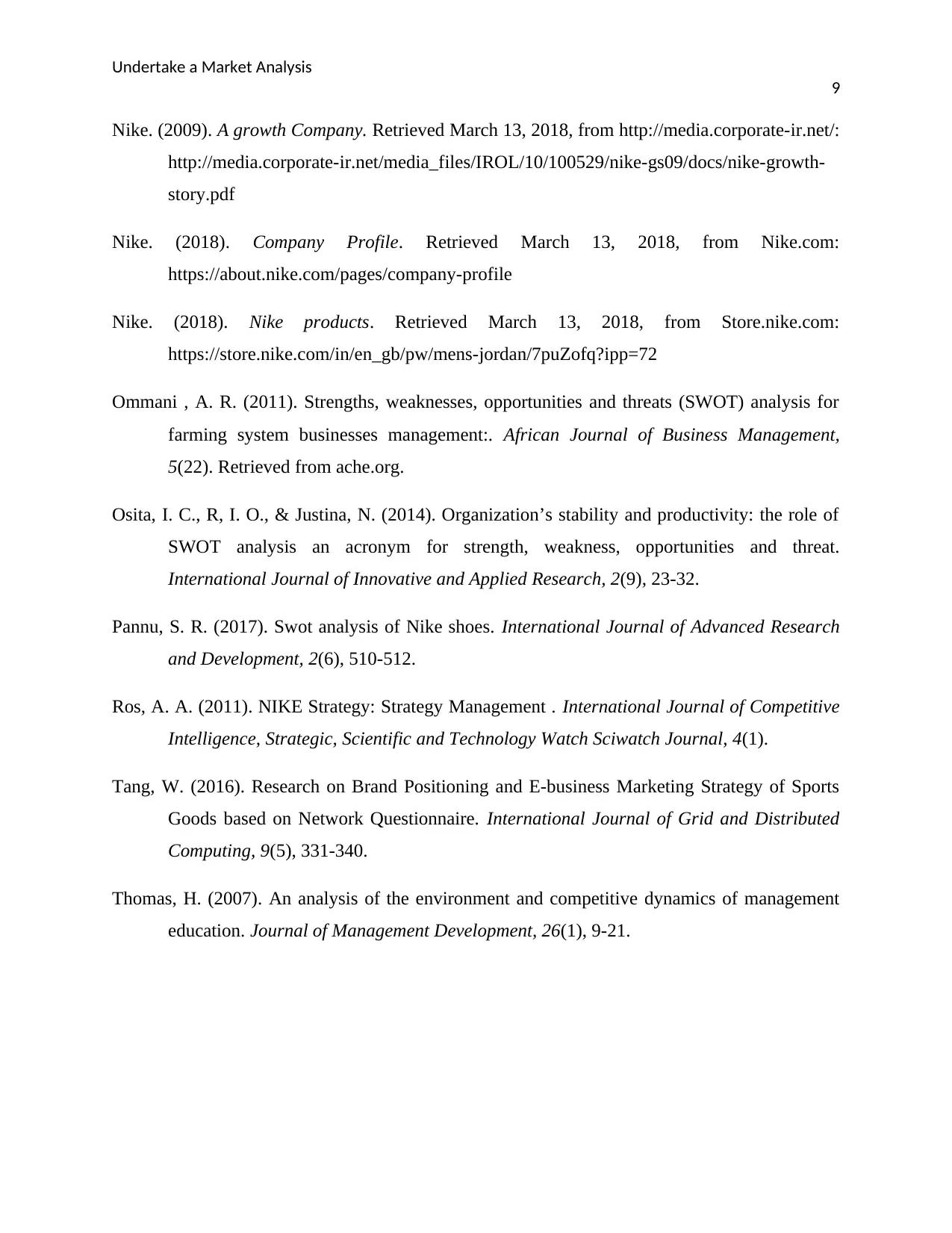
Undertake a Market Analysis
9
Nike. (2009). A growth Company. Retrieved March 13, 2018, from http://media.corporate-ir.net/:
http://media.corporate-ir.net/media_files/IROL/10/100529/nike-gs09/docs/nike-growth-
story.pdf
Nike. (2018). Company Profile. Retrieved March 13, 2018, from Nike.com:
https://about.nike.com/pages/company-profile
Nike. (2018). Nike products. Retrieved March 13, 2018, from Store.nike.com:
https://store.nike.com/in/en_gb/pw/mens-jordan/7puZofq?ipp=72
Ommani , A. R. (2011). Strengths, weaknesses, opportunities and threats (SWOT) analysis for
farming system businesses management:. African Journal of Business Management,
5(22). Retrieved from ache.org.
Osita, I. C., R, I. O., & Justina, N. (2014). Organization’s stability and productivity: the role of
SWOT analysis an acronym for strength, weakness, opportunities and threat.
International Journal of Innovative and Applied Research, 2(9), 23-32.
Pannu, S. R. (2017). Swot analysis of Nike shoes. International Journal of Advanced Research
and Development, 2(6), 510-512.
Ros, A. A. (2011). NIKE Strategy: Strategy Management . International Journal of Competitive
Intelligence, Strategic, Scientific and Technology Watch Sciwatch Journal, 4(1).
Tang, W. (2016). Research on Brand Positioning and E-business Marketing Strategy of Sports
Goods based on Network Questionnaire. International Journal of Grid and Distributed
Computing, 9(5), 331-340.
Thomas, H. (2007). An analysis of the environment and competitive dynamics of management
education. Journal of Management Development, 26(1), 9-21.
9
Nike. (2009). A growth Company. Retrieved March 13, 2018, from http://media.corporate-ir.net/:
http://media.corporate-ir.net/media_files/IROL/10/100529/nike-gs09/docs/nike-growth-
story.pdf
Nike. (2018). Company Profile. Retrieved March 13, 2018, from Nike.com:
https://about.nike.com/pages/company-profile
Nike. (2018). Nike products. Retrieved March 13, 2018, from Store.nike.com:
https://store.nike.com/in/en_gb/pw/mens-jordan/7puZofq?ipp=72
Ommani , A. R. (2011). Strengths, weaknesses, opportunities and threats (SWOT) analysis for
farming system businesses management:. African Journal of Business Management,
5(22). Retrieved from ache.org.
Osita, I. C., R, I. O., & Justina, N. (2014). Organization’s stability and productivity: the role of
SWOT analysis an acronym for strength, weakness, opportunities and threat.
International Journal of Innovative and Applied Research, 2(9), 23-32.
Pannu, S. R. (2017). Swot analysis of Nike shoes. International Journal of Advanced Research
and Development, 2(6), 510-512.
Ros, A. A. (2011). NIKE Strategy: Strategy Management . International Journal of Competitive
Intelligence, Strategic, Scientific and Technology Watch Sciwatch Journal, 4(1).
Tang, W. (2016). Research on Brand Positioning and E-business Marketing Strategy of Sports
Goods based on Network Questionnaire. International Journal of Grid and Distributed
Computing, 9(5), 331-340.
Thomas, H. (2007). An analysis of the environment and competitive dynamics of management
education. Journal of Management Development, 26(1), 9-21.
Paraphrase This Document
Need a fresh take? Get an instant paraphrase of this document with our AI Paraphraser

Undertake a Market Analysis
10
10
1 out of 11
Related Documents
Your All-in-One AI-Powered Toolkit for Academic Success.
+13062052269
info@desklib.com
Available 24*7 on WhatsApp / Email
![[object Object]](/_next/static/media/star-bottom.7253800d.svg)
Unlock your academic potential
Copyright © 2020–2025 A2Z Services. All Rights Reserved. Developed and managed by ZUCOL.





